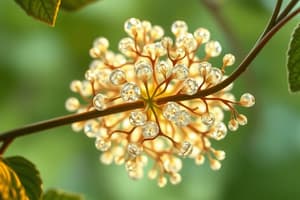Podcast
Questions and Answers
Explain how the process of photosynthesis directly supports the survival of heterotrophic organisms.
Explain how the process of photosynthesis directly supports the survival of heterotrophic organisms.
Photosynthesis produces oxygen, which heterotrophs need for respiration, and glucose, which serves as a primary source of energy when consumed.
Describe the specific role of chlorophyll in the process of photosynthesis.
Describe the specific role of chlorophyll in the process of photosynthesis.
Chlorophyll captures the energy of sunlight which then drives the conversion of carbon dioxide and water into glucose and oxygen.
Explain why photosynthesis is crucial for regulating the Earth's atmospheric composition.
Explain why photosynthesis is crucial for regulating the Earth's atmospheric composition.
Photosynthesis removes carbon dioxide from the atmosphere and releases oxygen. This balances the levels of these gases, which is vital for maintaining a stable climate.
What are the inputs required for photosynthesis to occur, according to the provided formula?
What are the inputs required for photosynthesis to occur, according to the provided formula?
Describe the relationship between chloroplasts and photosynthesis.
Describe the relationship between chloroplasts and photosynthesis.
Why is it important that photosynthesis produces glucose?
Why is it important that photosynthesis produces glucose?
How does the elodea experiment demonstrate that oxygen is produced during photosynthesis?
How does the elodea experiment demonstrate that oxygen is produced during photosynthesis?
Contrast the roles of carbon dioxide and oxygen in the process of photosynthesis.
Contrast the roles of carbon dioxide and oxygen in the process of photosynthesis.
What is the significance of photosynthesis for autotrophs?
What is the significance of photosynthesis for autotrophs?
How might deforestation impact the levels of carbon dioxide in the atmosphere?
How might deforestation impact the levels of carbon dioxide in the atmosphere?
Explain why photosynthesis is primarily a daytime process.
Explain why photosynthesis is primarily a daytime process.
Describe the specific adaptations that allow a plant's leaves to efficiently carry out photosynthesis.
Describe the specific adaptations that allow a plant's leaves to efficiently carry out photosynthesis.
How does the location of photosynthesis within the leaf cells enhance its efficiency?
How does the location of photosynthesis within the leaf cells enhance its efficiency?
Explain how the products of photosynthesis are utilized by plants for their growth and development.
Explain how the products of photosynthesis are utilized by plants for their growth and development.
Describe how environmental factors, such as temperature and water availability, can affect the rate of photosynthesis.
Describe how environmental factors, such as temperature and water availability, can affect the rate of photosynthesis.
How do aquatic plants obtain the carbon dioxide needed for photosynthesis?
How do aquatic plants obtain the carbon dioxide needed for photosynthesis?
What is the role of roots in the process of photosynthesis, even though they don't directly participate in it?
What is the role of roots in the process of photosynthesis, even though they don't directly participate in it?
Explain the connection between photosynthesis and the formation of fossil fuels over millions of years.
Explain the connection between photosynthesis and the formation of fossil fuels over millions of years.
How do plants manage to perform photosynthesis even in environments with low concentrations of carbon dioxide?
How do plants manage to perform photosynthesis even in environments with low concentrations of carbon dioxide?
If a plant is placed in a sealed container with a limited supply of carbon dioxide, what would happen to its rate of photosynthesis over time?
If a plant is placed in a sealed container with a limited supply of carbon dioxide, what would happen to its rate of photosynthesis over time?
Flashcards
Photosynthesis
Photosynthesis
Process where plants, algae, and some bacteria convert light energy into chemical energy (glucose).
Photosynthesis Equation
Photosynthesis Equation
6CO₂ + 6H₂O + light → C₆H₁₂O₆ + 6O₂: Carbon dioxide and water, using light, produce glucose and oxygen.
Chloroplasts
Chloroplasts
Organelles within plant cells, found in leaves, where photosynthesis occurs.
Autotrophs
Autotrophs
Signup and view all the flashcards
Oxygen Production
Oxygen Production
Signup and view all the flashcards
CO₂ Regulation
CO₂ Regulation
Signup and view all the flashcards
Elodea Experiment
Elodea Experiment
Signup and view all the flashcards
Study Notes
- Photosynthesis is how green plants, algae, and some bacteria convert the sun's light energy into chemical energy, stored as carbohydrates like glucose.
Simplified Photosynthesis Formula:
- 6CO₂ + 6H₂O + light → C₆H₁₂O₆ + 6O₂
- Plants absorb carbon dioxide (CO₂) through their leaves.
- Plants absorb water (H₂O) through their roots.
- Using sunlight captured by chlorophyll, plants convert these elements into glucose (sugar) and release oxygen (O₂).
Location of Photosynthesis:
- Photosynthesis occurs in chloroplasts, organelles within the cells of leaves and other green parts of the plant.
- This process requires light and mainly occurs during the day.
Importance of Photosynthesis:
- It forms the base of the food chain, where plants produce their own organic matter, making them autotrophs.
- Photosynthesis releases oxygen, which is essential for the respiration of all living organisms.
- It helps regulate carbon dioxide levels in the atmosphere.
Classic Experiment:
- Photosynthesis can be observed by placing elodea (an aquatic plant) in light, where oxygen bubbles form around the leaves, proving that the plant releases oxygen.
Studying That Suits You
Use AI to generate personalized quizzes and flashcards to suit your learning preferences.




